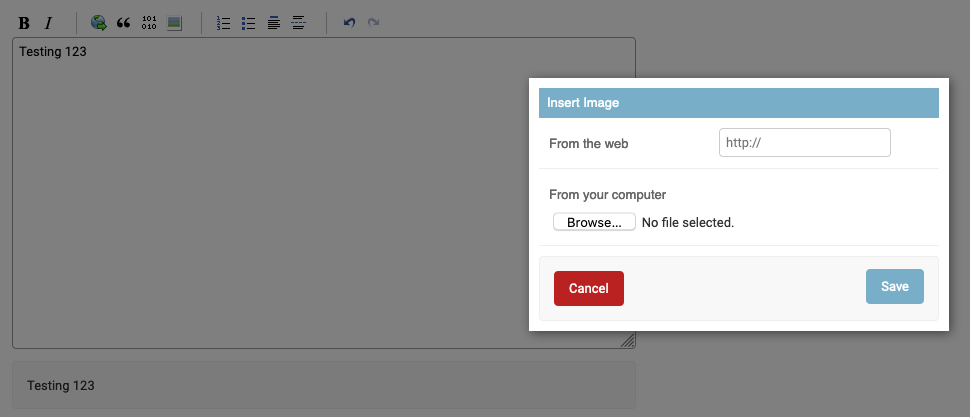
Security News
vlt Launches "reproduce": A New Tool Challenging the Limits of Package Provenance
vlt's new "reproduce" tool verifies npm packages against their source code, outperforming traditional provenance adoption in the JavaScript ecosystem.
A Django app that allows the easy addition of Stack Overflow's 'PageDown' markdown editor to a django form field
Add Stack Overflow's "Pagedown" Markdown editor to your Django Admin or custom form.

Version >= 2.0.0 of django-pagedown requires Django 2.1.0 or above (previous versions should support Django all the way back to around 1.1).
pip install django-pagedownpagedown.apps.PagedownConfig to your INSTALLED_APPS in settings.pypython manage.py collectstaticThe widget can be used both inside the django admin or independendly.
If you want to use the pagedown editor in a django admin field, there are numerous possible approaches:
To use it in all TextField's in your admin form:
from django.contrib import admin
from django.db import models
from pagedown.widgets import AdminPagedownWidget
class AlbumAdmin(admin.ModelAdmin):
formfield_overrides = {
models.TextField: {'widget': AdminPagedownWidget },
}
To only use it on particular fields, first create a form (in forms.py):
from django import forms
from pagedown.widgets import AdminPagedownWidget
from music.models import Album
class AlbumForm(forms.ModelForm):
name = forms.CharField(widget=AdminPagedownWidget())
description = forms.CharField(widget=AdminPagedownWidget())
class Meta:
model = Album
fields = "__all__"
and in your admin.py:
from django.contrib import admin
from forms import FooModelForm
from models import FooModel
@admin.register(FooModel)
class FooModelAdmin(admin.ModelAdmin):
form = FooModelForm
fields = "__all__"
To use the widget outside of the django admin, first create a form similar to the above but using the basic PagedownWidget:
from django import forms
from pagedown.widgets import PagedownWidget
from music.models import Album
class AlbumForm(forms.ModelForm):
name = forms.CharField(widget=PagedownWidget())
description = forms.CharField(widget=PagedownWidget())
class Meta:
model = Album
fields = ["name", "description"]
Then define your urls/views:
from django.views.generic import FormView
from django.conf.urls import patterns, url
from music.forms import AlbumForm
urlpatterns = patterns('',
url(r'^$', FormView.as_view(template_name="baz.html",
form_class=AlbumForm)),)
then create the template and load the javascipt and css required to create the editor:
<html>
<head>
{{ form.media }}
</head>
<body>
<form ...>
{{ form }}
</form>
</body>
</html>
If you want to customize the widget, the easiest way is to simply extend it:
from pagedown.widgets import PagedownWidget
class MyNewWidget(PagedownWidget):
template_name = '/custom/template.html'
class Media:
css = {
'all': ('custom/stylesheets.css',)
}
js = ('custom/javascript.js',)
contrib.markdown was deprecated in Django 1.5 meaning you can no longer use the markdown filter in your template by default.
@wkcd has a good example of how to overcome by installing django-markdown-deux:
{% extends 'base.html' %}
{% load markdown_deux_tags %}
...
<p>{{ entry.body|markdown }}</p>
...
You can enable image uploads, allowing your users to upload new images to the server and have them automatically inserted into the Pagedown widget (instead of just adding image URLs):

To do so:
MEDIA_URL and MEDIA_ROOT so that uploads will be propertly savedPAGEDOWN_IMAGE_UPLOAD_ENABLED=True to your settingsurls.py so that the upload endpoint is available # ...
urlpatterns = [
path('', include('pagedown.urls')),
# ...
]
This will add the URL /pagedown/image-upload/ endpoint to your project. You can see the default view that handles the upload here
The following options are available via your settings to tweak how the image upload works:
PAGEDOWN_IMAGE_UPLOAD_PATH can be used to change the path within your media root (default is pagedown-uploads)PAGEDOWN_IMAGE_UPLOAD_EXTENSIONS can be used to limit the extensions allowed for upload (default is jpg, jpeg, png, webp)PAGEDOWN_IMAGE_UPLOAD_UNIQUE can be used to ensure all uploads are stored in a uniquely named subfolder, e.g. f748e009-c3cb-40f3-abf2-d103ab0ad259/my-file.png (default is False)Check out the pagedown_init.js script to see how the upload is being performed on the client side.
You can see a fully-fledged example of the widget in django-pagedown-example
FAQs
A Django app that allows the easy addition of Stack Overflow's 'PageDown' markdown editor to a django form field
We found that django-pagedown demonstrated a healthy version release cadence and project activity because the last version was released less than a year ago. It has 1 open source maintainer collaborating on the project.
Did you know?

Socket for GitHub automatically highlights issues in each pull request and monitors the health of all your open source dependencies. Discover the contents of your packages and block harmful activity before you install or update your dependencies.

Security News
vlt's new "reproduce" tool verifies npm packages against their source code, outperforming traditional provenance adoption in the JavaScript ecosystem.

Research
Security News
Socket researchers uncovered a malicious PyPI package exploiting Deezer’s API to enable coordinated music piracy through API abuse and C2 server control.

Research
The Socket Research Team discovered a malicious npm package, '@ton-wallet/create', stealing cryptocurrency wallet keys from developers and users in the TON ecosystem.